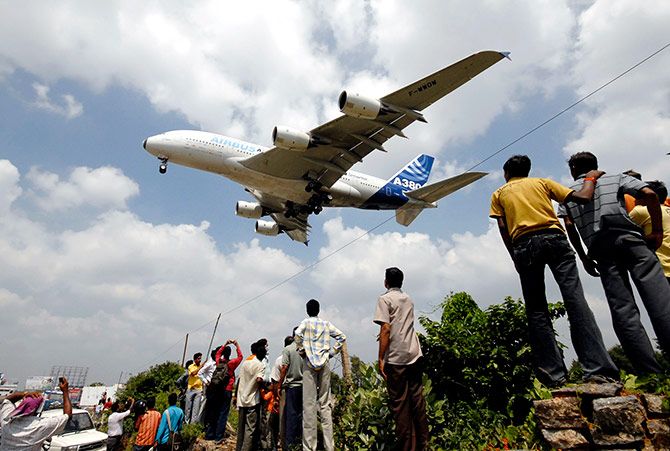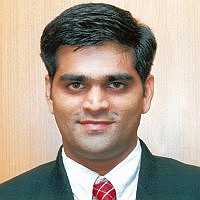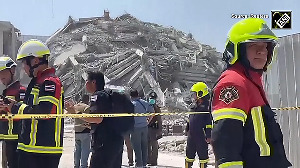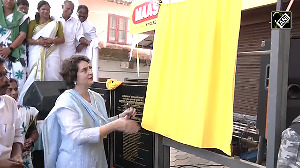'DGCA cares a damn for human life.'

Yeshwant Shenoy is determined to ensure the safety of fliers in India.
The Ernakulam lawyer has been doggedly highlighting various lacunae in the norms and laws governing India's civil aviation sector.
Shenoy, who has taken on India's civil aviation regulator, the Directorate General of Civil Aviation after the unfortunate Mangalore airport air crash in 2010, in a writ petition (pdf file) dated December 4, 2017, has sought a stay from the Delhi high court on 'all variations approved by Respondent No 2 (the DGCA; The Union of India is Respondent No 1) under the FDTL CAR (Flight Duty Time Limitation Civil Aviation Requirement).'
The next hearing in this matter is scheduled for March 20.
"What India did is in its FDTL CAR (Civil Aviation Requirement) they (the DGCA) have kept an exception which says that in exceptional circumstances the DGCA can allow different variations (for the number of hours a pilot can fly in a day) to the set prescriptive norms," Shenoy tells Rediff.com's Prasanna D Zore over the phone from Ernakulam.
"Airlines like Jet Airways and Air India have put in so many variations that pilots have to operate more than what the norm is (fly for more hours than the eight hours prescribed)," Shenoy adds.
In his PIL, Shenoy maintained that 'through Clause 4 of the FDTL of CAR of the DGCA, variations were allowed to air operators without any scientific study on risk assessment in violations of their own regulations.'
According to a PTI report, acting Chief Justice Gita Mittal and Justice C Harishankar of the Delhi high court, which heard the case on December 6, observed, 'This is very dangerous. These are matters where you (the Centre and the DGCA) need to take steps', and asked the aviation regulator to place before it the flight timings and duty timings of pilots.
"I have been dealing with these people (DGCA) since 2010 after the Mangalore air crash," Shenoy, below, left, tells Rediff.com. "They are lying in court; they are used to it; they care a damn for human life."
Why did you file a PIL in the Delhi high court highlighting the DGCA's acts and omissions of India's aviation regulator, the Directorate General of Civil Aviation that compromises aviation safety and consequently the life of the flyers and people on ground?
Essentially, this petition is about 'pilot fatigue'.
There are international norms and standards on how the pilots should operate.
India is violating these international norms by making these pilots work over time.
What are these international norms and how are Indian pilots violating them?
These international norms are different for different countries, different for different timings, different for different aircrafts and different for different settings.
If I begin explaining the international norms to you it will take lot of time.
How is India violating the norms laid down by the International Civil Aviation Organisation (ICAO)?
Actually, DGCA itself is involved in the violation (of the international norms related to Flight Duty Time Limitation, FDTL).
There is not just the violation (by the DGCA) ,but it is also deceiving the international community.
There are two types of pilot fatigue management methods: Prescriptive method in which the time for which a pilot can fly is fixed, say 8 hours a day; this cannot be increased to nine hours but can be reduced to seven hours, which India is following.
Now, what India did is in its FDTL CAR (Civil Aviation Requirement) they (the DGCA) have kept an exemption which says that in exceptional circumstances the DGCA can allow different variations to the set prescriptive norms.
Airlines like Jet Airways and Air India has put in so many variations that pilots have to operate more than what the norm is (fly for more hours than the eight hours prescribed).
The problem is when the ICAO team comes for audit they show the FDTL as a prescriptive norm. But what they do because of these 'exceptions' is they use performance based fatigue management principles which India is not qualified to use.
For qualifying to use this principle you need a strong, independent safety directorate, a strong safety management system, which India doesn't have and doesn't qualify for evaluating pilot fatigue on this parameter.
These 'exceptions' are approved by the DGCA under the performance-based norms where the DGCA is telling the world that India is following prescriptive norms and that is deceptive and fraudulent practice.
In 2007 draft FDTL did come out but all the air operators went to the then Union aviation minister Praful Patel telling him it (following the draft FDTL) will cost them 30 per cent more to operate their flights.
This draft FDTL was then watered down and in 2011 they (the DGCA) came in with a very diluted FDTL and in that FDTL they introduced a clause wherein 'exemptions' can be allowed and Jet Airways and Air India have undertaken too much of variation and the results were immediate.

What were these results? How did this watered-down FDTL affect the safety of the fliers?
If you see my petition I have put in just three incidents.
In an Air India flight coming from Bangkok to Delhi in May 2013, the pilot was so sleepy, that he put the plane in auto pilot mode, asked an air hostess to take the pilot's seat and went and slept in the business class.
The air hostess turned off the auto pilot; this aircraft could have crashed as a result of this pilot fatigue. German fighters had to escort the aircraft.
This year one Jet Airways flight (in February 2017) and one Air India flight (in March 2017) missed the communication from the ground traffic controller and immediately Eurofighters were scrambled out to accompany it safely to the airport.
These fighter aircraft are scrambled only when there is no response from a flight.
They (the air traffic controller in Germany, Belgium and Hungary) thought it was a hijack, but basically what had happened was these pilots were so tired that they slept inside the cockpit and were not responding to signals.
Didn't the European civil aviation authorities take action against these airlines?
What happened was it was treated as an 'incident' and India should have investigated this matter.
I have my doubts if ever Indian civil aviation authorities investigated any of these incidents.
Also, the DGCA was quick to blame wrong radio frequencies for there being no response from the pilots of these planes to the signal sent by the air traffic control there.
What evidence do you have to prove that these pilots were sleeping only because of fatigue and not because of any other reason?
You give me an answer. Why would a pilot sleep mid-flight?
If a pilot is sleeping in the cockpit, then it is not controlled rest. This is something that the operators should worry about.
The Delhi high court observed that the FDTL issue is very dangerous and the Centre and DGCA should take steps to avoid it.
What steps can be taken to prevent fatigued pilots from flying aircraft?
What steps will the DGCA take when they themselves are deceptively doing it? Do you seriously think they will take any steps?
I have been dealing with these people since 2010 after the Mangalore air crash. They are lying in court; they are used to it; they care a damn for human life.
I have put this in my affidavit also.
I will be soon sending a mail to the DGCA stating that if any life is lost from this moment because of pilot fatigue then they will be held responsible for such deaths primarily because they have misled the court.
Main Photograph: Krishnendu Halder/Reuters. Kindly note the image is posted only for representational purposes.











 © 2025
© 2025